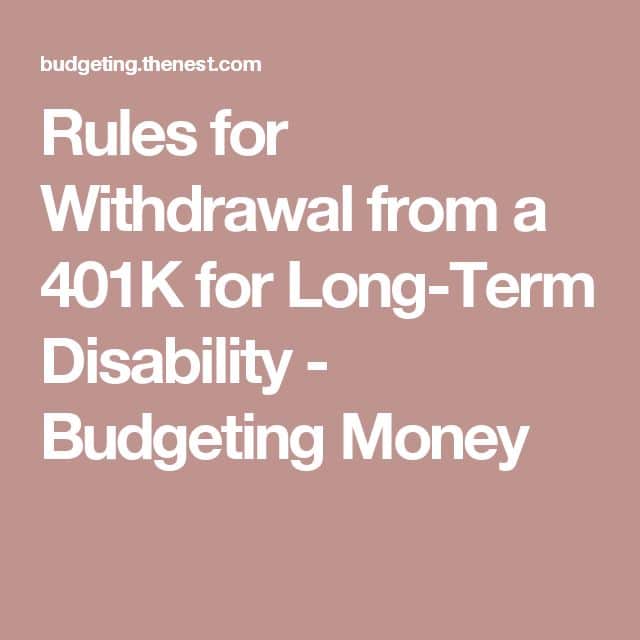When Should You Make A 401 Early Withdrawal
Considering the 10% penalty, financial planners often advise taking an early withdrawal from your 401 as a last resort. Since penalty-free withdrawals are available for a number of financial hardships and situations, plan participants who take an early withdrawal with a penalty are often in serious financial straits.
Ive seen people take withdrawals for a number of reasons, Stiger says. Everything from a childs tuition to a spouses burial expenses the hope is that distributions are used for larger, more unexpected expenses like medical emergencies, keeping a home out of foreclosure or eviction, and in a down period, putting food on the table.
Taking an early withdrawal can make sense if you are able to take advantage of a penalty-free exception, use the Rule of 55 or the SEPP exemption. But might make sense to exhaust other options firstcheck out these 10 ways to get cash now. And keep in mind, contributions to a Roth IRA can always be withdrawn without penalty if youre truly in a bind.
How 401 Hardship Withdrawals Work
A hardship withdrawal is an emergency removal of funds from a retirement plan, sought in response to what the IRS terms “an immediate and heavy financial need.” It’s actually up to the individual plan administrator whether to allow such withdrawals or not.
Manythough not allmajor employers do this, provided that employees meet specific guidelines and present evidence of the hardship to them.
Rules For Withdrawing From A 401 For Long
According to the IRS, 401s are tax-favored, employer-sponsored accounts that you can fund with pre-tax or after-tax wages to prepare for retirement. Both employers and employees can contribute these funds.
Because of the tax advantages that 401s are structured to offer, withdrawing money from them may be considered a tax event. Not only may you be required to pay regular taxes on the distributions, but you may also be forced to pay a penalty for early withdrawal. However, there may be some exceptions, however, such as long-term disability.
You May Like: Why Did I Get Two Social Security Checks This Month
When You Can Take Your Money From The Annuity And 401 Retirement Plan
Generally, a distribution of your entire Individual Account may be made when you retire or you become disabled , or you die.
- Retirement. Under the Plan, retirement means that you separate from service, are at least age 55, and are receiving a pension benefit from the NEI Pension Fund or receiving Social Security retirement payments.
- Disability. You are considered disabled under the Plan if the Social Security Administration determines that you qualify for Social Security Disability benefits.
- Death. If you die, your spouse or other designated beneficiary will receive your Individual Account balance. If you dont have a surviving spouse and you havent designated one or more beneficiaries under this Plan, or your designated beneficiaries die before you, your benefit will be paid to the person or persons you designated to receive a life insurance benefit under the terms of the National Elevator Industry Health Benefit Plan. Otherwise, your benefit will be paid to your estate.
Hardship Withdrawalsunderstand The Tax Bite And Long

Under certain circumstances, it may be possible to access your 401 funds before retirement. Check with your employer for the specifics of your plan. A hardship withdrawal should be a choice of last resort. You will never get the full amount that you withdraw because you will have to pay taxes.
Hardship withdrawals generally are:
- Available if your employer’s plan permits them, but are not required by law
- Not loansthey cannot be repaid
- Subject to regular taxesyour employer will likely deduct 20% up front
- Subject to a 10% penalty tax if you are not 59 ½ or older
- Available only after you have withdrawn all other available 401 funds
- Not available after you have been terminated.
Hardship withdrawals are allowed to:
- Purchase or repair a primary home
- Pay education tuition, room and board, and fees for the next 12 months for you, your spouse, children, and other dependents
- Prevent eviction or foreclosure on your primary residence
- Address severe financial hardship
- Pay for unreimbursed medical expenses for you, your spouse, children and other dependents
- Pay for funeral expenses for immediate family membersparents, spouse, children, and other dependents.
The 10% penalty tax is waived if your hardship withdrawal results from:
Hardship withdrawals are costly in the short term when you pay taxes. Over the long term, they also cost you when the withdrawn funds are not there to grow with the help of compounding.
Read Also: Can You File For Disability After Age 65
Bipartisan Budget Act Changes
There is other good news about accessibility: The Bipartisan Budget Act passed in January 2018 issued new rules that will make it easier to withdraw a larger amount as a hardship withdrawal from a 401 or 403 plan:
An additional change for 2019 was that you are no longer required to take a plan loan before you become eligible for a hardship distribution. However, whether or not you will be allowed to take a hardship distribution is a decision that still remains with your employer. Your employer may also limit the uses of such distributions, such as for medical or funeral costs, as well as require documentation.
Although a hardship withdrawal might be eligible to avoid the 10% penalty, it still incurs income taxes on the sum you withdraw.
Rules For Withdrawal From A 401k For Long
The IRS expects you to take money from your 401 when you’re in your 60s and 70s, not next week. If you start withdrawing 401 money before age 59 1/2, you add a 10 percent tax penalty to the regular income tax on your withdrawals. The IRS allows some exceptions, one of which is a permanent disability.
TL DR
You may be able to take penalty-free early withdrawals from your 401 if you can meet the IRS requirements for early withdrawals and show proof that your disability is severe enough. You can expect to need to obtain documentation about your condition and contact your plan administrator to begin taking out money.
Don’t Miss: How To Apply For Disability In Iowa
Government Pensions And Social Security Benefits
Retirement or annuity payments you receive through a government pension can reduce the amount of your Social Security disability payments. This is because most contributions to government pensions and annuities are tax-free. The SSA refers to this reduction as an offset, and provides information on how the calculation of benefits works in its Government Pension Offset pamphlet.
Consequences Of A 401 Early Withdrawal
- IRS Penalty. If you took an early withdrawal of $10,000 from your 401 account, the IRS could assess a 10% penalty on the withdrawal if its not covered by any of the exceptions outlined below.
- Withdrawals are taxed. Even if it were covered by an exception, all early withdrawals from your 401 are taxed as ordinary income. The IRS typically withholds 20% of an early withdrawal to cover taxes. So if you withdrew $10,000, you might only receive $7,000 after the 20% IRS tax withholding and a 10% penalty.
- Less money for retirement. Perhaps the biggest consequence of an early 401 withdrawal is missing out on long-term returns in the market. The stock markets average returns have been around 9.6% a year since the end of the Great Depression. If you withdrew $10,000 from your 401 and were about 30 years away from retirement, you could be giving up more than $117,000 in total returns.
Read Also: What Percentage Of Va Disability Claims Are Approved
Risks Of A 401 Early Withdrawal
While the 10% early withdrawal penalty is the clearest pitfall of accessing your account early, there are other issues you may face because of your pre-retirement disbursement. According to Stiger, the greatest of these issues is the hit to your compounding returns:
You lose the opportunity to benefit from tax-deferred or tax-exempt compounding, says Stiger. When you withdraw funds early, you miss out on the power of compounding, which is when your earnings accumulate to generate even more earnings over time.
Of course, the loss of compounding is a long-term effect that you may not feel until you get closer to retirement. A more immediate risk may be your current tax burden since your distribution will likely be considered part of your taxable income.
If your distribution bumps you into a higher tax bracket, that means you will not only be paying more for the distribution itself, but taxes on your regular income will also be affected. Consulting with your certified public accountant or tax preparer can help you figure out how much to take without pushing you into a higher tax bracket.
The easiest way to avoid these risks is to resist the temptation to take an early 401 withdrawal in the first place. If you absolutely must take an early distribution, make sure you withdraw no more than you absolutely need, and make a plan to replenish your account over time. This can help you minimize the loss of your compound returns over time.
How To Make An Early Withdrawal From A 401
When you have determined your eligibility and the type of withdrawal you want to make, you will need to fill out the necessary paperwork and provide the requested documents. The paperwork and documents will vary depending on your employer and the reason for the withdrawal, but when all the paperwork has been submitted, you will receive a check for the requested funds, hopefully without having to pay the 10% penalty.
You May Like: How Much Do You Get For Disability In Nc
Offsets For Other Forms Of Income
In addition to deducting Social Security disability benefits, the vast majority of LTD policies offset other forms of income such as state short-term disability benefits, workers’ compensation benefits, and third-party settlements . Common sources of income that are not offset include 401 plans, individual retirement accounts, severance packages, stock options, and profit-sharing plans.
Occasionally the amount of a recipient’s deductible income, whether from Social Security or other sources, actually exceeds the monthly LTD payment. In these instances, rather than paying you nothing, most policies provide for a minimum monthly benefit of $50 or $100 that a person can collect regardless of the offset amount.
What Is A 401 Early Withdrawal

First, lets recap: A 401 early withdrawal is any money you take out from your retirement account before youve reached federal retirement age, which is currently 59 ½. Youre generally charged a 10% penalty by the Internal Revenue Service on any withdrawals classified as earlyon top of any applicable income taxes.
If youre making an early withdrawal from a Roth 401, the penalty is usually just 10% of any investment growth withdrawncontributions are not part of the early withdrawal fee calculation for this type of account.
But the entire account balance counts for calculating the fee if youre making an early withdrawal from a traditional 401. These rules hold true for early distributions from a traditional IRA as well.
Also Check: How Many 100 Percent Disabled Veterans Are There 2020
Calculating The Withdrawal Amount
There are three different methods you can choose for calculating the value of your withdrawals:
A trusted financial advisor can help you determine which method is most appropriate for your needs. Regardless of which method you use, youre responsible for paying taxes on any income, whether interest or capital gains, in the year of the withdrawal.
This Is Possible Through The Recently Passed Cares Act
This act allows employees to gain access to retirement funds without some of the negative tax consequences that would otherwise be in place. You have to be a qualified individual in order to take these distributions, but many will certainly qualify. You can take up to $100,000 out of your which might just be enough to get you through this crisis.
Don’t Miss: Does Adhd Count As A Disability
Next Steps To Consider
With respect to federal taxation only. Contributions, investment earnings, and distributions may or may not be subject to state taxation.
This information is intended to be educational and is not tailored to the investment needs of any specific investor.
Keep in mind that investing involves risk. The value of your investment will fluctuate over time, and you may gain or lose money.
Fidelity does not provide legal or tax advice. The information herein is general and educational in nature and should not be considered legal or tax advice. Tax laws and regulations are complex and subject to change, which can materially impact investment results. Fidelity cannot guarantee that the information herein is accurate, complete, or timely. Fidelity makes no warranties with regard to such information or results obtained by its use, and disclaims any liability arising out of your use of, or any tax position taken in reliance on, such information. Consult an attorney or tax professional regarding your specific situation.
Fidelity Brokerage Services LLC, Member NYSE, SIPC, 900 Salem Street, Smithfield, RI 02917
How To Avoid The Early Withdrawal Penalty
There are a few exceptions to the age 59½ minimum. The IRS offers penalty-free withdrawals under special circumstances related to death, disability, medical expenses, child support, spousal support and military active duty, says Bryan Stiger, CFP, a financial advisor at Betterments 401.
If you dont meet any of those qualifications, you arent entirely out of luck, though. Youve got a couple of options that may let you make penalty-free withdrawals, if youre slightly younger than retirement age or plan your withdrawals methodically.
If youre between age 55 and 59 ½ and you lose your job, the IRS will allow you to withdraw from your 401 plan penalty-free. This is called the Rule of 55, and it applies to everyone within this age group who loses a job, no matter whether youre fired, laid off or voluntarily quit. Stiger says. To qualify for the Rule of 55, the 401 you hope to take withdrawals from must be at the company youve just parted ways with. Note that the Rule of 55 does not apply to IRAs.
There is also the Substantially Equal Periodic Payment exemption, or an IRS Section 72 distribution, say Stiger. With SEPP you can take substantially equal payments from your 401 based on life expectancy. Unlike the Rule of 55, you may use SEPPs to tap an IRA early.
Also Check: Is Adhd Considered A Learning Disability
New Bill Helps Retirees With Long
When planning for the future, health care ranks as one of the highest concerns for both savers and retirees alike. Not only are health care costs rising by more than 5% every year, but rampant inflation and volatile market performances have also added extra pressure to retirement savings, making many older Americans wonder if they can retire after all.
New legislation aims to ease some of the worries: House Financial Services Committee member Ann Wagner has introduced a bill to help reduce the cost burden of long-term care. Over half of all individuals over the age of 65 are expected to need some form of long-term care by 2030, and this new bill may help you pay for it.
A financial advisor could help you plan for retirement and help you determine if withdrawing early from your retirement accounts is appropriate for you. Find a qualified advisor today.
Representative Introduces New Bill to Help With Long-Term Care
On March 16, Rep. Wagner introduced the Long-Term Care Affordability Act. Long-term care ranks as the second greatest financial concern for Americans, right behind retirement savings, and this bill aims to provide favorable tax treatment to help.
Why Is Long-Term Care Insurance Important?
How Retirement Savers Can Take Advantage
Bottom Line
Retirement Planning Tips
Income Taxes Are Still Due
The exemption for a permanent disability only exempts the 10 percent early withdrawal tax penalty, not any income taxes due on the distribution. So, dont expect to be able to withdraw all of your money without paying any taxes because of your disability. Instead, make sure you budget for both federal income taxes and any applicable state income taxes.
Don’t Miss: Can You Collect Unemployment After Being On Short Term Disability
Does Retirement Age Affect My Long Term Disability
If you need to use your long term disability insurance close to retirement, eligible time frames can change based upon your age. Typically, long term disability is paid out for a certain number of years and up to a certain age. Many plans will pay out until age 65 or retirement age under social security. Of course, if you can return to work before the maximum time runs out under your policy, then these dates are not an issue. Remember, long term disability is meant to replace a portion of your income only during the time that your disability keeps you from being able to work. Insurance companies routinely challenge your ability to return to work as time passes, but you still need to know what is potentially available to you and for how long.
Living With A Disability

If you become totally and permanently disabled, getting access to your retirement account early becomes easier. In this case, the government allows you to withdraw funds before age 59½ without penalty. Be prepared to prove that youre truly unable to work. Disability payments from either Social Security or an insurance carrier usually suffice, though a doctor’s confirmation of your disability is frequently required.
Keep in mind that if you are permanently disabled, you may need your 401 even more than most investors. Therefore, tapping your account should be a last resort, even if you lose the ability to work.
Also Check: Social Security Office Abilene Texas
